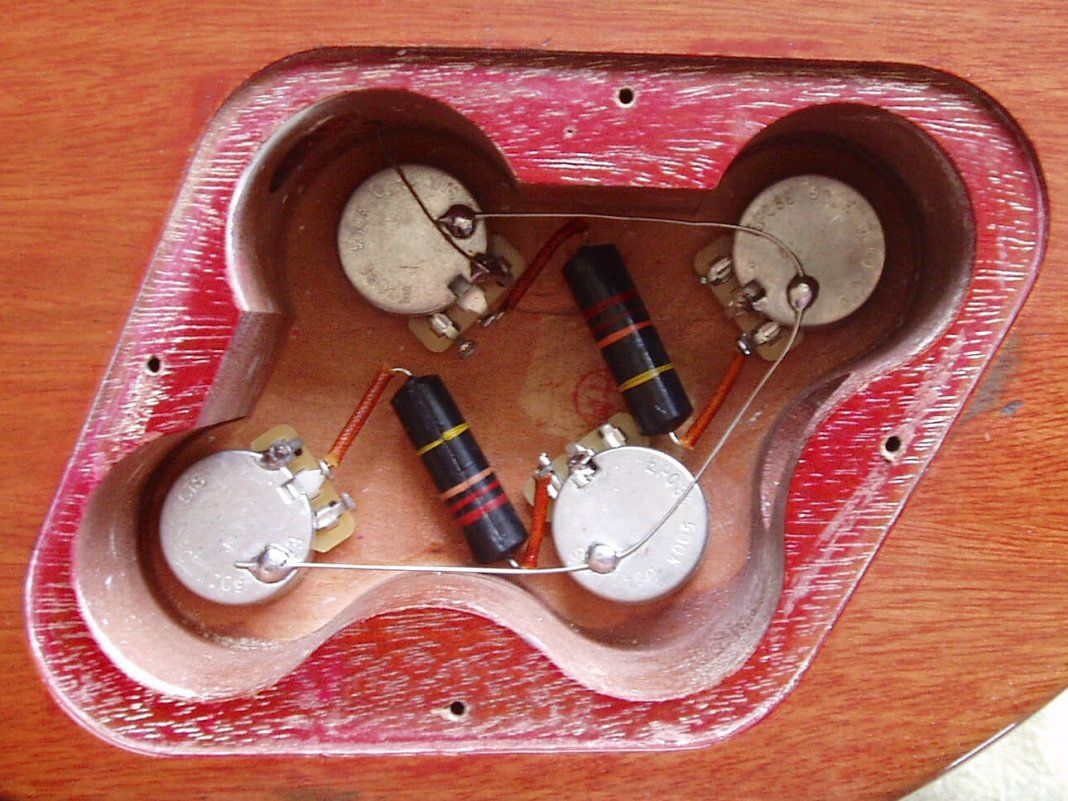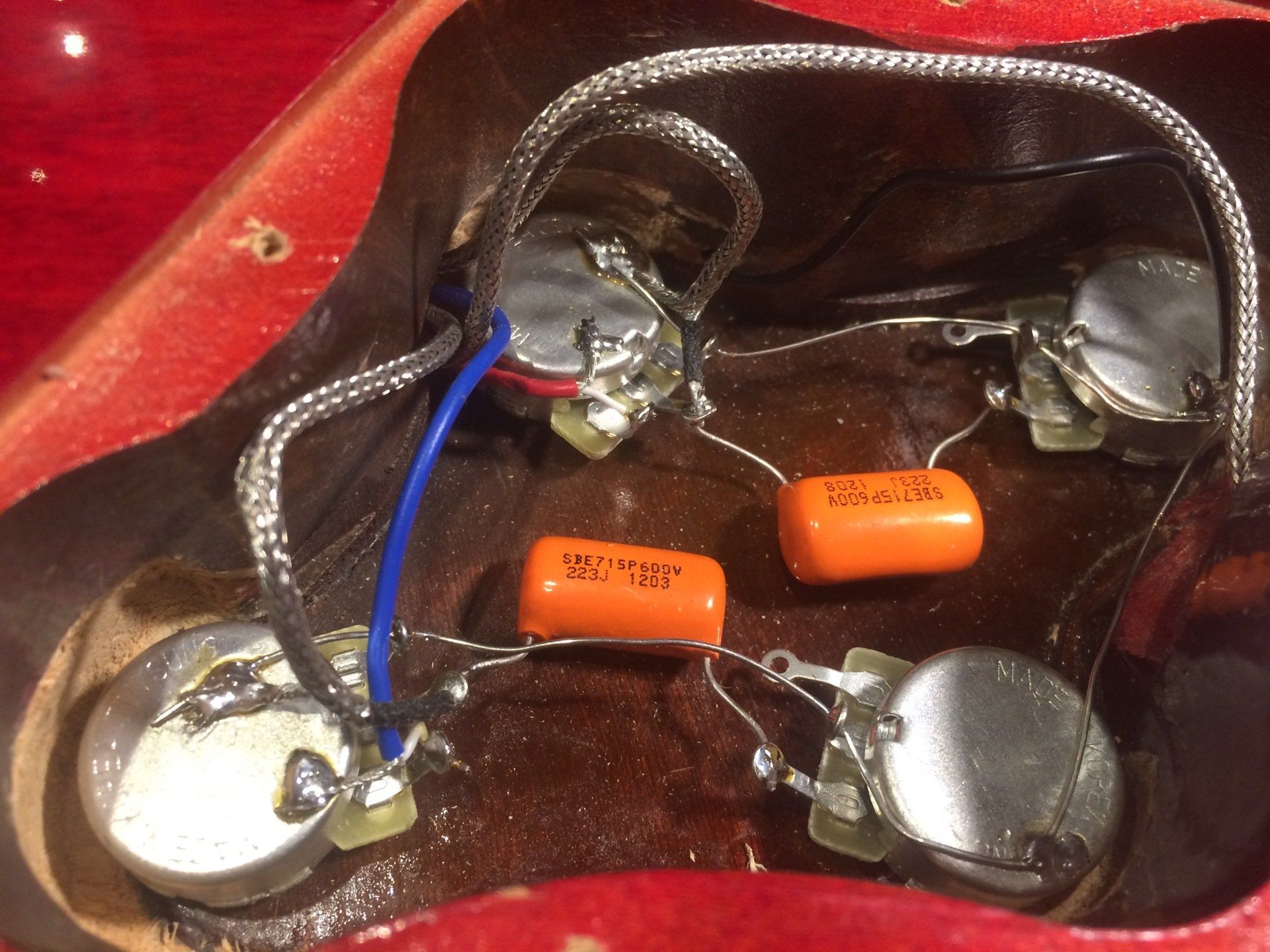Burst in to song...
… how do you 'harness' that voice?
What is it about “The Burst” that is so covetable? Is it the list of great players who’ve employed it over the years? Is it the tone that could be wrung from it’s neck? Is it the look of the thing? That book-matched maple cap, the shape, the balance? Well of course it’s all of these things and more. And none of these characteristics sit in isolation — all of these factors are connected after all. Many guitarists are attracted to the look of a 1959 Les Paul Standard, particularly one with beautiful flame or quilting in the grain. But for the great players who adopted the Les Paul tone in the sixties it had to be about just that: The Tone. And there are a lot of elements to that tone. Let’s get the arguments started then: hands up who thinks the combination of a book-matched maple cap on a mahogany body is the fundamental factor in the sound of a classic LP? Nobody going to jump in with what grade number of Alnico the magnets usually were in PAFs from 1958-60? There are very noticeable tonal qualities that depend upon the grade of aluminium in the tailpiece, the zamak alloy of an original ABR-1 bridge. Perhaps the real experts among you will be stroking your chins and remarking upon the enhanced brilliance and sustain that comes of a long tenon neck joint. And of course some will already be talking about 6/6 Nylon nuts as opposed to bone replacements (anyone going to bring up the anachronistic 4/6 Nylon stock found at Kalamazoo?); or brass saddles versus nylon on LPs compared to ESs and whether or not to wrap the strings around the stopbar*. Now these are all valid factors in the voice of a Paul but can I just point something out? How many of you out there have compared a modern Les Paul to a vintage one? Quite a select group I suspect, but I’m not being rhetorical here. What I really want to ask, is how many of you have compared “Gibson '50s wiring” to “Gibson Modern wiring”? I’ll tell you now — they are very different beasts.
If you’re looking to recreate vintage Les Paul tones then you need to know how the wiring harnesses were different in vintage Gibsons, compared to the standard circuit today. And I'm not just talking about Paper-In-Oil capacitors I’m talking about the truly great guitar voices found by people who started picking up those abandoned, nay orphaned, 1950s Les Paul Standards in the '60s for their expressive timbres. I’m talking about people like Peter Green, Jeff Beck and Danny Kirwan. Not everybody understands why vintage Les Pauls worked the way they did for those guys. These players used the tone and volume controls on their Les Pauls extensively because they could get a huge range of quality tones out of those old guitars — and the reason they could do this was because Gibson wired their guitars differently back then. We’re not just talking about Lesters here, but also early SGs, ES3** guitars and most other early Gibson twin pickup models as well. All this changed sometime in the late '60s when Gibson started to use what’s called “modern wiring” which gives more separation between pickups but limits the range of the controls. Modern wiring is easier for the kids to get their heads around but it makes for somewhat redundant controls. They just don’t really do much and, I feel, compromise the tone when they do. And the end result is that people don’t bother to use the controls on their guitars. They just keep them “dimed” and never bother to do anything subtle or interesting. People often don’t realise that the types of capacitors and potentiometers in a regular, passive treble-bleed tone circuit have little effect on the sound when the knobs are turned all the way up. With the tone knobs set to ten they are pretty much bypassed. For many modern amateur guitarists a Les Paul might as well only have a selector switch between the pickups and the jack socket; perhaps a master volume for the occasional fade, or to move down to a clean sound and back up to overdrive. In fact look at the controls of dual humbucker guitars made in the late '80s — they often had just a three way toggle and a single volume. And for the high-gain pop-metal era it was kind of what people needed, especially if the sound engine was DiMarzio Super Humbuckers through a Mesa Dual Rec.

The way original Les Paul models were wired, until they stopped making them in early 1961 (with the last original black Les Paul Customs), is what’s now known as “50's wiring”. This actually differs radically from modern Gibson wiring — but you wouldn’t think so to look at it. At first glance '50s and Modern Les Paul wiring don’t look much different at all. The capacitors bridge different tabs between the Volume & Tone potentiometers and the latter are grounded from different tabs, but otherwise not much has changed, has it? There are plenty of comparative diagrams and photos of the two types of wiring harness online for you to compare. In the '50s circuit the T pots have the middle tab (lug 2, i.e. the sweeper) bent to ground on the pot casing instead of lug 1. And lug 1 has the cap attached to it — so lug 1 is the hot output to the switch. The volume pots look the same, well except that the capacitors connect to the same tabs as the switch on the V pots (tag 2) in the '50s circuit. In the modern version the caps connect to the same tabs as the pups (tag 3). Can such a slight change in electronic linkage have much effect? ‘How much difference could this possibly make?’, you ask. Well actually, it’s very noticeable indeed. I’ve made up '50s style harnesses and even with Orange Drops rather than Paper-in-Oils they sound really good and very different to the Modern style of wiring.
In the original circuit the volume and tone controls are more interactive. When you roll down the tone knob it will cause a slight volume drop. And rolling down one of the volumes to zero in the middle switch position will cut out both pickups. This however was how guitarists first discovered the toggle switch could create the classic stutter of a kill switch when repeatedly flicked. Another consequence of the older circuit is that the overall output is slightly lower. However I don’t think it really sounds much quieter
— probably due to the more open character of the sound with '50s wiring. Some people see these characteristics as negatives
—
I don’t believe they are, but anyway, there are other positives to the '50s harness that far outweigh them. When you roll down the volume knob you do not hear the same sudden loss of treble that occurs in the modern circuit. As the volume control is being turned down the signal is also bypassing more of the tone pot & cap, so you lose fewer high frequencies to the output. And those high frequencies sound clearer and more rounded
— without the fizz you sometimes get from a treble bypass cap & resistor. The classic “treble bypass” addition to the traditional passive tone pot is the usual solution to the treble loss that occurs with modern volume controls. It lets a set range of the highest frequencies through, determined by the values of the resistor and capacitor in parallel, and sometimes that bandwidth won’t have been calculated very carefully for a nice treble tone.
“So hang on a minute,” I hear you say, “the volume controls affect the tone, and the tone controls affect the volume?” Yep, and they do so in a complimentary way that sounds fantastic. The slightly lower overall output of the '50s circuit is compensated by a fuller, more open sound with clearer high frequencies. But the biggest advantage of the '50s circuit is a greater range of real quality tones. And it’s a really easy modification to make — and just as easy to reverse. You can try it in any good budget LP without even buying new parts. I would still recommend getting some good pots and caps if you decide you like it. Even that can be done cheaply; long shaft logarithmic Alpha pots are cheap, well made and have a vintage taper that is very close to the originals used by Gibson. NOS Russian PIOs or even Sprague Orange Drops can be found fairly cheaply and will sound as close to the original tone caps as the expensive repro look-a-like Bumblebees that aren’t always real PIOs and even if they are, they are Russian K-40Y-9s in disguise anyway.
* Wrapper's delight
Wrapping the tailpiece is done for a number of reasons. As far as tuning goes, some people claim it helps with the intonation of a plain 3rd string which often causes problems and can pull sharp (and nobody's comfortable with a sharp pulling G-string). The main reason for wrapping is usually where the strings, when threaded straight through the stopbar, create too steep an angle off the back of the saddles and are bending over the back of the bridge body as well as the saddle. This is a frequent cause of string breakages. I’ve found Tune-O-Matics where there was a deep cut into the bridge body behind the saddle from long time string wear. Even when the string isn’t touching here, a steep break angle can cause string snapping if the saddle has a sharp edge. But this is why the stopbar has studs which can be raised up to make the string break-angle over the bridge much shallower. Many people believe that you get much better sustain and resonance when the stopbar is screwed down tight to the body however, and there would seem to be some truth to this. A much bigger factor in sustain however, is how welll made the various parts of the bridge and tailpiece are and how well they fit together. If the threads aren’t snug or the post holes are too loose then the mechanical transmission of vibration is impeded and the audio coupling suffers. This is why Tonepros can charge so much money. I’ve had good results with Epiphones by upgrading to Gotoh hardware, which is reasonably priced but really well made and designed to fit Epis with no body modification needed.
So, if you clamp the stopbar right down but wrap the strings back up over it, you hopefully have better sustain but you reduce the break angle. A lot of people do it just because their hand feels comfortable like this or they find palm muting easier. Many people say that you get a freer movement of the strings through the saddles which makes them feel looser and easier to bend and I think this is true. It is also believed that the “bridge collapse” syndrome that many original ‘50s bridges are prone to is less likely to occur if the stopbar is wrapped. The original Zamak aluminium alloy of the first ABR-1s has amazing tone but is quite a soft metal and the vintage ones have often bent and sagged in the middle from string pressure. There’s a school of thought that says the lower break angle exerts less pressure (true) and therefore prevents T-O-M collapse. I read somewhere that Gibson originally always wrapped the strings in the factory on the early T-O-M & Stopbar fitted guitars, I’ll see if I can find the quote and I’ll past it below.
Here’s the quote from p.147 of Robb Lawrence's book
The Early Years of the Les Paul Legacy
where he talks about Goldtops and the introduction of the Tune-O-Matic bridge:
"To complete the assembly, the new bridge was used in conjunction with the stop/stud tailpiece — this being generally placed 1 9/16" behind the center of Tune-O-Matic bridge to anchor the strings. Today, many people are unaware that, originally, these items were depicted in the catalogs and shipped normally with the strings over the top of the tailpiece (the way it was designed). This original stringing method is naturally comfortable to rest your hand on at the bridge area. With the studs screwed in deeply for full vibratory string-to-body contact, the guitar's overall sound is enhanced as it was intended. It also helps to prevent the strings from breaking as easily on the sharp metal edges. Furthermore, instead of the tension just pulling on the stud screws laterally, when wrapped around the stop bar, it torques the tension in the body differently (as inherent with the Goldtop's big tone). The original method results in more body resonance and better acoustic tone."


